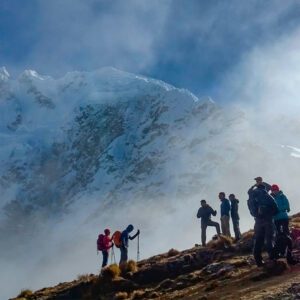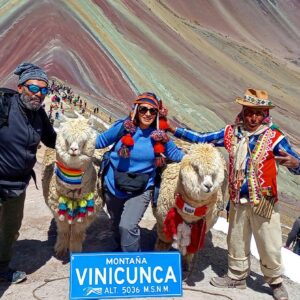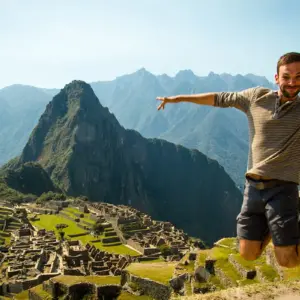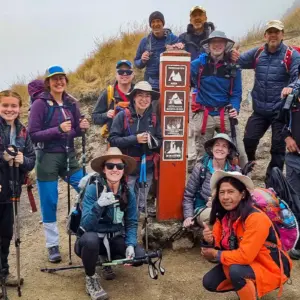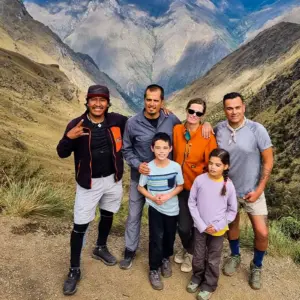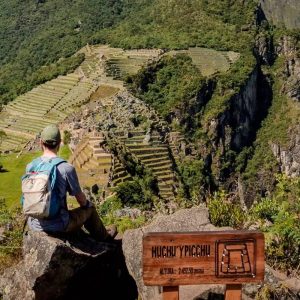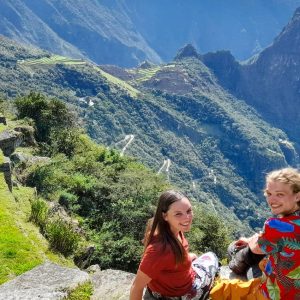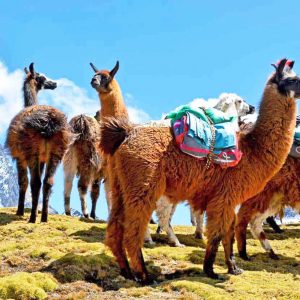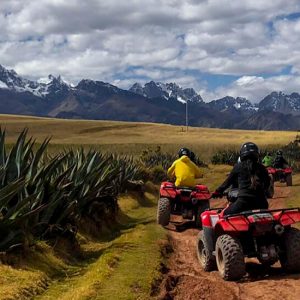The Inca Trail to Machu Picchu is one of the most beautiful hikes in the world. Spanning an approximate 63 KM in distance and crossing through the splendor of the Andean mountains, the Inca Trail grants access to some of the most impressive Inca archaeological sites located in areas otherwise inaccessible.
The Inca Trail hike begins in the Sacred Valley at the trailhead of Piskakucho – KM 82. Hikers are welcomed into the trail by the friendly faces of the local inhabitants, most of who sell last-minute items such as coca leaves and snacks for the intrepid souls ready to take on the trail. From Piskakucho – KM 82 onwards, no cars or cargo animals are allowed. From this point onward, only hikers, porters, and guides proceed to hike along the Inca stone paths leading to Machu Picchu citadel.
The trail not only takes hikers along valleys and through mountain passes, but it also grants hikers access to the archaeological sites of Patallacta / Llactapata, Runkurakay, Sayacmarca, Phuyupatamarca, Inti Pata, Winay Wayna, and Intipunku. The Inca Trail leads directly to Machu Picchu and offers the hike of a lifetime.

Patallacta/Llactapata
Patallacta is the first archaeological complex along the classic Inca Trail. Located at 2,840 m.a.s.l., this site is thought to have been an agricultural and administrative support site to Machu Picchu. The most impressive feature of this archaeological site is its complex system of terraces dedicated to the cultivation of crops.
As the first stop along the Inca Trail, the Patallacta site serves as a welcome to visitors and sets the stage for even more formidable views of the surrounding landscapes and imposing Inca constructions.

Runkurakay
The archaeological site of Runkurakay is known for its semicircular construction seemingly perched above the clouds. This complex is surrounded by thick vegetation and the towering mountain ranges that serve as the perfect backdrop. Based on its prominent location at 3,760 m.a.s.l., this site is thought to have served either as a resting place for travelers and pilgrims, or a control post. This site is a perfect stop along the Inca Trail hike where you can enjoy magnificent views of the Inca trail, and explore the exquisite variety of flora and fauna.
Visitors can enjoy views of the famous Dead Woman´s Pass (Warmi Wañusca Pass) and its mountain silhouette from Runkurakay as well. This pass is the highest location (4,200 m.a.s.l.) reached when hiking to Machu Picchu via the Inca Trail. Besides its altitude, this mountain pass offers travelers one of the most rewarding moments of the Machu Picchu hike. The altitude and geographic characteristics of the trail leading to the Dead Woman´s Pass create a strenuous hike for most hikers. This is often worsened by altitude sickness experienced due to altitude changes. However, all the efforts exerted by most hikers are then rewarded by the awe-inspiring views of the valleys below.
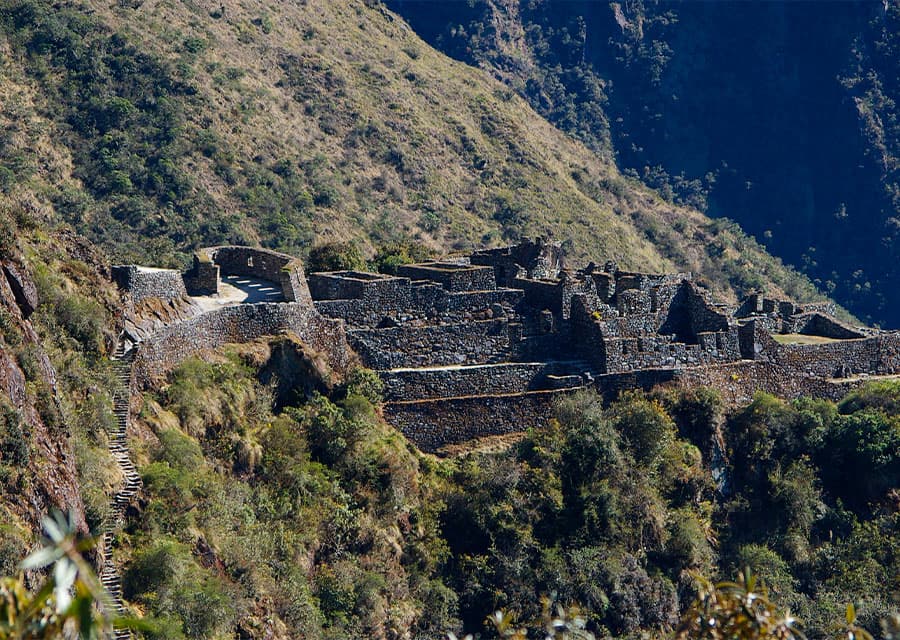
Sayacmarca
Sayacmarca rests at the top of a mountain at approximately 3,600 m.a.s.l. The visit to this archaeological site grants views of the Aobamba valley and the Pumasillo snow-capped mountain. The site´s structure is composed of maze-like paths and tightly organized enclosures. Its structures are all built on the edge of the precipice and have led experts to deduce that this location had ceremonial and astrological uses during the Inca empire.

Phuyupatamarca
Known as the ¨place of the clouds,¨ Phuyupatamarca is yet another impressive Inca ruin along the Inca trail. Its construction is another prime example of the Inca philosophy of perfect balance between humans and nature. This site is composed of terraces carved into the mountainsides, enclosures, and ritual baths. The latter is still being replenished by an underground river. Another fascinating characteristic of this site is its sophisticated hydraulic system which is still being used today to irrigate the various zones of the complex.
Phuyupatamarca is also an excellent lookout point due to its elevation at 3,670 m.a.s.l., granting views of Intipata and Wiñaywayna.

Intipata
Intipata archaeological site is considered to be one of the hidden gems of the Inca Trail to Machu Picchu. This site is relatively close to Machu Picchu and is thought to have had a shortcut to reaching the famous UNESCO site. Experts believe the Intipata site to have been built for agricultural purposes. Nowadays, we can still appreciate the evidence of canals to water crips distributed among the levels of terraces in the ruins.
Although the visit to Intipata is often considered optional while on the Inca Trail hike, travelers should not pass the opportunity to watch the splendor of the rising sun rays over the landscape and terraces of the complex.

Wiñay Wayna
The Inca complex of Winay Wayna is one of the most impressive along the Inca Trail. Located at 3,800 m.a.s.l., Winay Wayna is only 4 KM away from Machu Picchu and serves as the last camping spot of the Machu Picchu hike. Just as in previous archaeological sites, Winay Wayna was skillfully carved onto the mountainside. There are terraces and enclosures all throughout the complex leading experts to deduce the possible uses of the site as a farming and administrative center. The site is complemented by a high waterfall and views of the Urubamba gorge and Apu Veronica.
Inti Punku – Sun Gate
Inti Punku is directly translated into ¨Sun Gate¨ or ¨Sun Door.¨ It serves as the entry point to Machu Picchu citadel when hiking the Inca Trail to Machu Picchu. Experts indicate that during the Inca empire, the Inti Punku served as an entry and checkpoint for pilgrims entering the citadel. It was also used for ceremonial purposes in the worship of Inti (Sun God) during the winter solstice.
Nowadays, the Inti Punku offers spectacular and unmatched views of the Machu Picchu complex before entering. Travelers along the Inca Trail are rewarded with such views upon completion of the Machu Picchu hike.

Machu Picchu
The enigmatic citadel of Machu Picchu is world-renowned and recognized for its architecture and historical importance. Named Cultural and Natural Heritage Site by UNESCO, Machu Picchu is without a doubt, a prime example of ancient ingenuity and balance between nature and humans. The complex of Machu Picchu is located at 2,400 m.a.s.l., between the high Andes and tropical rainforest, better known as cloud forest. It is rich not only in history but also in flora and fauna endemic to the region.
To date, the exact purpose of the complex is still a mystery. Its temples, terraces, walls, palaces, and enclosures leave visitors and experts with immense wonder. Most visitors are left without sufficient words to describe the intricate constructions and precise rock shapes.
The Inca Trail to Machu Picchu is one of the most emblematic travel experiences in the modern world. In contrast to any other hike in the region, the Inca Trail does not finish in the town of Aguas Calientes. In fact, the Inca Trail is the only trail that leads directly into Machu Picchu via the imposing Inti Punku. As a result, the Inca Trail offers direct access to the mysteries of the Inca empire and some of the most exquisite views and landscapes of the region.
Hiking to Machu Picchu via the Inca Trail should be on every traveler´s checklist. This hike is an example of the type of adventure that cannot be described just by words. The Inca Trail hike along with all the archaeological sites found along the way have to be experienced in person to be fully embraced and understo













